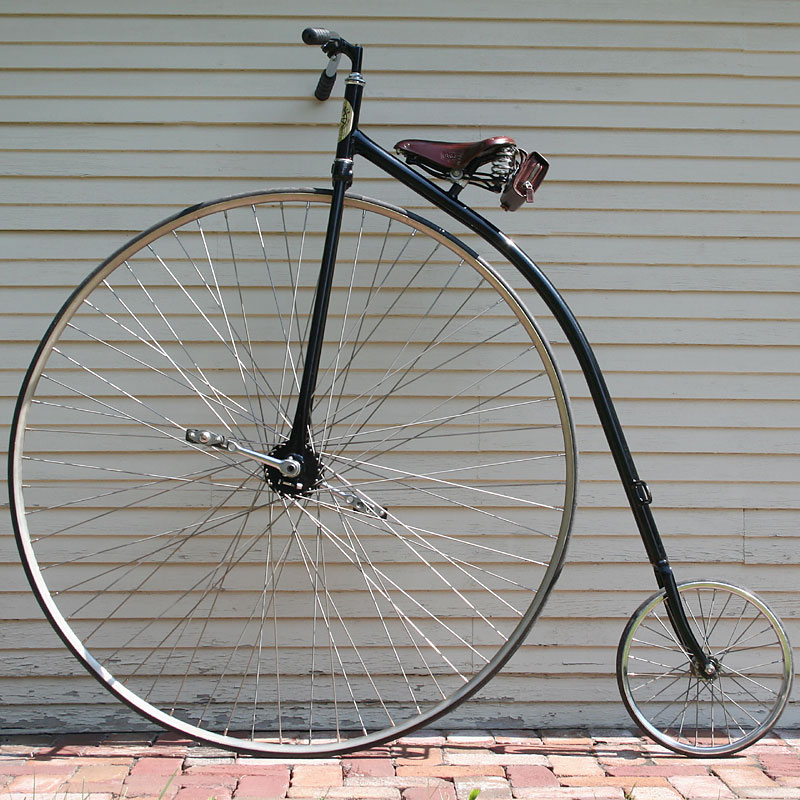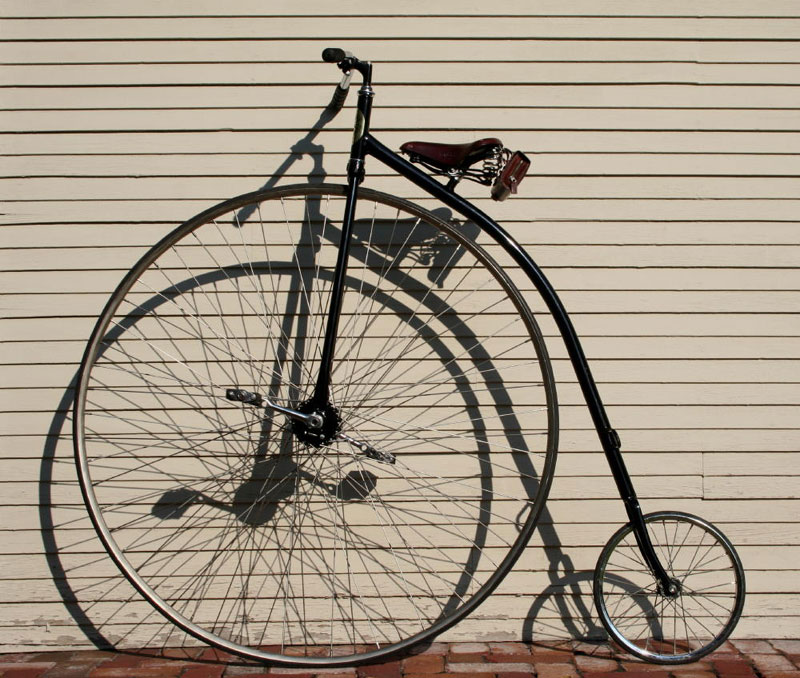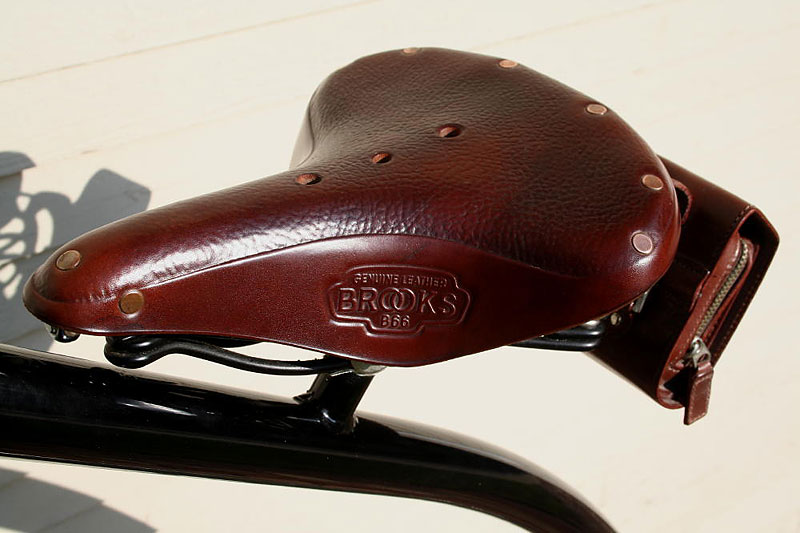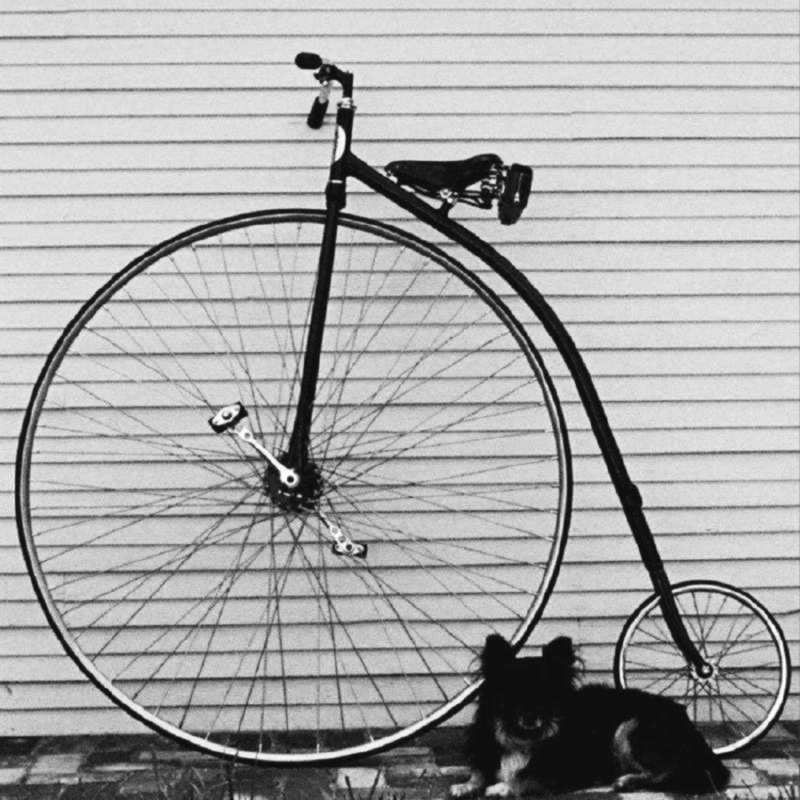|
Highwheel - Single Speed You may call a bicycle like this one a "highwheel" or a "highwheeler" or a "penny-farthing" or an "ordinary". I'm not sure if you can say it's exactly a "fixed-gear", since it doesn't have any cogs or gears or teeth of any kind. But we can be sure, just as with any fixed-gear bicycle, when the wheels roll, the pedals will move. That front wheel carries some inertia! This bicycle is a reproduction, made by "Rideable Replicas", in southern California, U.S.A. This bicycle fits in several categories at Cyclofiend! It's certainly a Modern Classic. Since the original designs were made for dirt roads, and this one has traveled on dirt roads many times, you might even call it Cyclocross. But I think Single Speed seems the best fit. This is a very basic model from the manufacturer. The maker calls this model a "Boneshaker". Technically, a proper "boneshaker" is an even older design, from even farther back in time. Technically, this is not really a "boneshaker". Mine is not exactly new anymore. I believe mine was made in the year 2000. It's amazing how quickly such details can blur with a little time. I think it was made in the year 2000. This one only has a 48-inch front wheel. Way back in the 1880s , a 48-inch front wheel was not considered so very large. My legs are long enough to allow an even larger front wheel, if the design were a little different. I'm glad this one is designed the way it is! If you take a very close look at photos of real racing bicycles from the 1880s, you'll see the front forks are almost exactly straight up and down. You'll also see the saddles were placed as far forward as possible. Finally, you'll notice almost no space between the tire and the backbone of the frame. All of these features, plus a well designed saddle, made sure that the rider could have the absolutely largest front wheel possible! The larger the front wheel, the higher the top speed! It was all about SPEED! But, if you slide that rider's saddle, and therefore the rider's weight, further back . . . Well then, the rider is much less likely to get thrown forward over the handlebar! This reproduction here is much less likely to toss me all alone into forward flight! I'd rather not go flying solo! The steering angle is more laid back. The backbone of the frame doesn't exactly follow the curve of the wheel. The saddle is much farther back on the backbone of the frame. This all means I can only ride a 48-inch wheel. But that's o.k. The view is still pretty spectacular! As you can see, I also have the pedals way out there, in the farthest holes. This gives a crank length of perhaps just a hair more than 180mm. I'd like to call these 181mm cranks. I need to mention the saddle. The machine came with a fascinating saddle that was hand-made of real leather in India. If you look closely, perhaps you can see the stub of a little seatpost, on the backbone of the frame. This modern feature allows a small amount of adjustment, and also allows modern choices in seats! I bought a brand new Brooks B.66 Saddle. As the folks at Brooks would say, this is made of Genuine Brooks Leather. I don't know just how old is the design of the B.66 from Brooks. But I know it looks entirely appropriate on this highwheel! The Brooks Saddle allows me to get down just a wee bit lower and closer to the backbone of the frame. It's the Brooks Saddle that lets me use the full 180mm setting on the cranks. It also provides a very nice spring-y ride! I've gotten to know the parts of this machine. Honestly, I have to report there were problems with the original front fork. The manufacturer cheerfully replaced it. So, I assembled it that first time, very soon after it arrived. I had it apart twice, to replace front wheel bearings (part of the problem with the original fork). Then I had it apart to replace the front fork. It helps to have a "cotter-pin-press"! It's a shame Park Tool stopped making their fine version. I'm glad to have one from a few years back (thanks Sarah!). Each time I put the cranks back on, I used fresh new cotters. By the way, the front wheel bearings are modern sealed precision bearings. They should last long, long decades of time. When I had it apart to replace the front fork, I may have been a bit too timid in reassembly. The left crank worked itself loose. The machine and I were only about 3 miles from home. We limped back. I took the left crank off, wiped everything clean, re-greased everything, grabbed a new cotter, and put it all back together. That's when I noticed the broken spoke! I may have broken that spoke, and started the cotter loosening itself, in some small spill. Who knows? I ordered a half dozen spare spokes from the manufacturer. I told myself I was silly for not ordering spare spokes much sooner! When the spokes arrived, I decided to make it more interesting. I picked out a replacement and polished it by hand, so it'd be just a tiny bit different, and maybe I could find it in the future. Replacing the spoke was very easy, no trouble at all. Note - stainless steel spokes , 60 of them , straight gauge , 3mm x 555mm (or maybe 556mm) , just exactly 21 and 7/8 inches , laced cross 5. After replacing the spoke, I was surprised to feel how loose all of the spokes had become. When I first assembled it, I'd checked the spokes after the very first couple of original test rides. But with some number of miles, I guess I'd finally "broken-in" that big wheel! I trued and tightened and trued the wheel again. After that I checked and re-checked, before and after the next several rides. It was snug and solid, tight and true! And yes, with the spokes all freshly tightened, I thought I could just barely feel the machine was a tiny bit livelier. Actually, I was surprised the difference was almost unnoticeable! This past "Summer Of Ought Seven" was the best for this us, this bicycle and me. We went out three or four times a week, most every week. The folks out on those gravel and dirt roads, have gotten to know us. The county does a wonderful job of grading those gravel and dirt roads. The best rides were about 36 hours after a rain, when things were smooth and firm, but not dusty. A dusty-dry surface can be just as slippery as a muddy one! Traction, especially traction while climbing up-hill, is always a concern. Five to eight miles out, and the same back, makes a nice ride. Three or four times I've gone on two rides in the same day. Once, I took her on a ride of perhaps 25 miles. That's the longest so far. We'll be doing more of those this coming summer! And did I mention the view from up there is spectacular ??? I'm addicted to it !!! Hill-climbing, and hill-descending, is a big issue. Any riding on a bicycle with such limited braking ability requires planning ahead. Hills require the most planning. I'm not shy about getting off and walking down a truly steep hill. I've only had to do that a couple of times. Normally, on the up-hills, I'll just plan to avoid the worst hills, and climb whatever comes my way. I'm not the strongest rider around, but the 48-inch wheel, with the 180mm cranks, allows me to huff and puff up most of the steep but fairly short hills around here. There have only been a couple of times, while climbing a truly steep bluff, when I've simply come to a complete halt, and fallen over! No worries. Falling over at a slow walking pace is harmless. Remember the days when the "gears" on every bicycle were measured in "gear-inches" ? Remember when 27-inch wheels and tires, with a 52 x 14 combination of teeth, would give you a "100-inch-gear" ? I suppose these days it's a 700 x 23mm tire, with a 53 x 13 combination of teeth, yields a "107-inch-gear". This highwheeled bicycle of mine, gives a true 48 inches, from the outside edge of the tire, to the outside edge of the tire, no matter what! And with the talk of gears, I'll pause, and say, thank you Sheldon. I can't ride fixed without thinking of Sheldon. http://www.sheldonbrown.com/gears :^) R.
|
|
 |
|
 |
|
 |
|
 |
|
 |
|
Current
Classics Photo Gallery - Cross Bike
Photo Gallery
Single Speed Garage Photo Gallery
-
Working Bikes & Practical Hardware
Submit a Single Speed Bicycle Photo